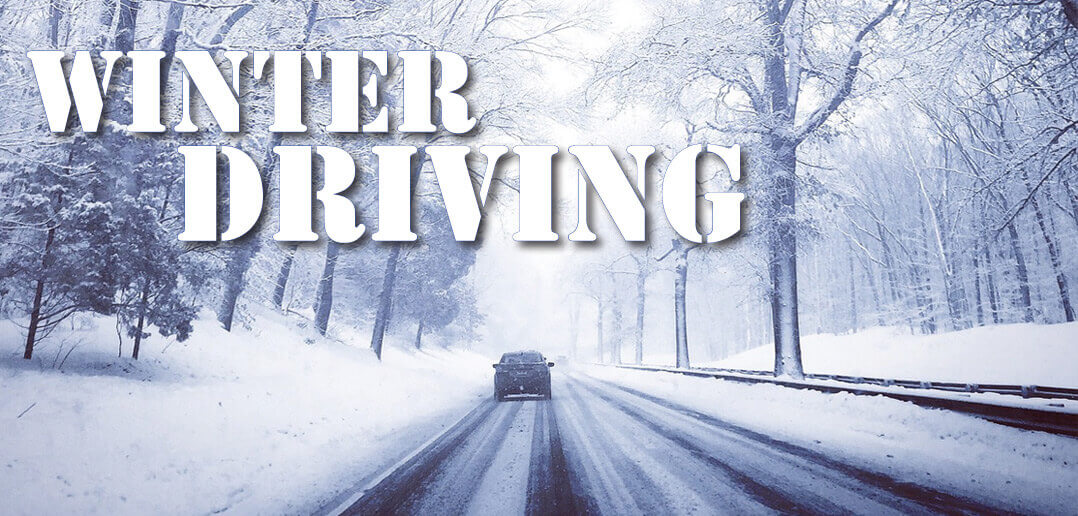Winter Driving in Lincoln, Nebraska
Winter driving, particularly given the fluctuating and often treacherous nature of the weather conditions we experience here in Nebraska, is not to be taken lightly. In fact, there are a number of safety measures to be taken in order to ensure that you and your family can safely travel from Point A to Point B whenever it’s necessary to do so. While much of this might seem to be common sense for many of you who are reading this, it’s well worth revisiting this time of year just to make sure that all necessary precautions have been taken. Consider this a prime example where we can all get behind the Boy Scouts motto: Be Prepared!
“Winter driving presents a number of challenges to you and your car,” advises Sherri Stock of inMOTION Auto Care. “Cold weather can be hard on your car and winter weather can test your abilities as a driver. Therefore, it pays to be prepared. Here are our tips to get ready for snow and sleet-covered roads, and freezing temperatures. We hope you find them useful.
1. If your car needs regular service, get it done now.
Breaking down is never convenient, but it’s worse in the winter than any other time of year. Since bad hoses, belts, water pumps and spark plug wires can leave you stranded, it’s better to take care of them before cold weather really hits. It’s a far better option than spending the same amount of money after you’ve been sitting in your car waiting for roadside assistance.
Here’s one service item that’s often forgotten: tire pressure. Ask your mechanic to check it, or do it as soon as winter arrives. Why? Because tire pressure drops by about one pound for every 10 degrees the temperature drops. So, when it’s 20 degrees and the last time you checked your tire pressure was back during that heat wave in July, your tires will be dangerously low and will jeopardize your car’s handling.
Many newer vehicles have tire pressure monitors, which alert you to dangerous changes in tire pressure. As of 2008, tire pressure monitors are required on all new vehicles. But older cars don’t have them, and the pressure needs to be checked manually.
2. Make sure your battery and charging system are up to snuff.
Your mechanic should check the battery, charging system, and belts. Your battery can leave you stranded simply because it’s old and lousy. Or it could leave you stranded because your charging system isn’t working well, and the battery isn’t getting charged properly. It’s a good idea to have a trusted technician test the battery and charging system.
If you find that you need a new battery, get the biggest, meanest, ugliest battery that will fit in your car. Two things to remember about batteries: First, the battery that started your car easily in the summer may not have enough oomph to do it in winter. In winter, the engine is harder to start, because the oil isn’t as “fluid” as it was last July. And secondly, batteries lose power as the temperature drops (you remember your high school chemistry, right?). So not only do you need MORE power to start the engine in winter, you also get LESS power from the same battery.
3. Check the cooling system.
Make certain the antifreeze will protect your car at the winter temperatures we experience in Nebraska. Around here that means a 50-50 mix of coolant to water, which is good to -34 degrees. If you’re taking a winter trip someplace insanely cold like Northern Minnesota, you can up the ratio to 70 percent coolant and 30 percent water, but by no means use more than 70 percent anti-freeze.
But that’s still only half the story. The other primary function of antifreeze is to keep your cooling system from rusting. The rust inhibitors in antifreeze break down over time and need to be renewed. So, at a minimum, change your engine’s coolant every 5 years. Besides, a good coolant exchange (flush) service also removes dirt and rust particles that can clog up the cooling system and cause problems, regardless of the season.
4. Make sure your windshield wipers are in good shape.
You should replace your windshield wipers at minimum once a year. At inMOTION we recommend changing them every 6 months. It’s a simple and inexpensive way to ensure that you have good visibility year-round.
When using your wipers in the winter, remember to turn them off BEFORE shutting off the engine. Why? If your blades freeze to the windshield, when you go to start your car, the wiper motor may burn out trying to get them back to the “rest” position.
5. Keep your gas tank at least half full.
If you do get stuck or stranded in the winter, you’ll want to be able to keep the heater running. You can run the engine indefinitely at idle to stay warm-or as long as you have gas. No harm will be done to the engine.
If you have an older vehicle, we suggest you crack open the window a bit if you are going to be idling the engine. Older cars are more likely to suffer from exhaust leaks and rust holes. If you’re sitting for a long time while carbon monoxide is slowly leaking into the passenger compartment and if you are pulled over and stopped in the midst of a humungous snowstorm, be sure to get out periodically and remove snow from behind the tailpipe to keep it unobstructed.
6. Make sure your windshield washer reservoir is full.
On a snowy or messy day, you can easily go through half a gallon or more of windshield washer fluid trying to keep your windshield clear. For that reason, it’s also a good idea to keep some extra fluid in the trunk in case you run out. FYI – There is a difference between washer solvent used in the winter verses what is used in the summer. The chemical additive package is adjusted in winter to alter the freeze point of the washer solvent.
7. Know your car.
Every car has different handling characteristics. You should know what both you and your vehicle are capable of in the snow. (Hint: It can’t do any of the things it was doing on the TV commercial that made you buy it.) It’s not a bad idea to do a little driving in an empty parking lot on a snowy day, just so you know what to expect from your car when you drive on snowy roads.
8. The single biggest safety feature you can buy for the winter.
Nothing will make a bigger difference to your ability to drive safely in the winter than good tires. They increase your traction when you’re starting out, braking and turning.
9. Make sure you have some basic supplies in your car in case you do get stuck.
Invest in a substantial snowbrush and an ice scraper. It’s good to have a shovel and a bag of sand to help with traction, and the aforementioned extra windshield washer fluid. A blanket is a good idea and some yummy snacks—just in case. If you have any winter clothes you don’t wear anymore, especially an old pair of boots, hat, and gloves throw them in the trunk, too.
10. Clean off your car – entirely!
Once snow or ice does arrive, take some extra time to make sure your car is clean and your visibility is good. Clear off the entire car, not just a little peephole in the windshield. You need just as much, if not more, visibility in poor conditions because you have to keep your eyes peeled for pedestrians, and every other knucklehead on the road. Make sure every glass surface is clear and transparent by using a snowbrush and/or ice scraper. Your side-view mirrors, and all lights should be brushed and cleared as well.
Now, if you haven’t been smart enough to do so already, clean the snow off the rest of the car. Why? Because the rest of the snow will either: (A) Slide off the roof and cover your windshield as you’re slowing down; or (B) Fly off onto someone else’s windshield causing him or her to smash into you.
11. Clean your headlights. Even if you think they don’t need it.
If your headlights are covered with snow and ice, your visibility will be greatly reduced and other drivers are going to have a hard time seeing you. Salt, sand and other wintry crud can dramatically impair the effectiveness of your car’s headlights, even long after the last snowstorm. Whether you’re planning on driving at night or not, take a moment before every winter trip to clean off your headlights.
12. When driving in the snow, go slow.
Even with good coolant, good tires, stability control, all-wheel drive, and the bag of Doritos in the trunk, keep in mind that driving in snow, sleet, and ice is very treacherous. And even if you maintain control of your car, not everyone else will. So don’t ever get lulled into a false sense of security. Do everything slowly and gently. Remember, in the snow, the tires are always just barely grabbing the road. Accelerate slowly and gently, turn slowly and gently, and brake slowly and gently. To do this, you have to anticipate turns and stops. Go slowly and leave plenty of distance between yourself and other vehicles. Rapid movements lead to skids and loss of control.
Going back to #8, as the only part of your vehicle that touches the road, your tires are a key component responsible for ensuring the safety of occupants while travelling treacherous roads. When we think of preparing our vehicle for winter conditions, tires usually come to mind first because that’s a widely accepted fact. Much research and development has gone into engineering tires to handle inclement conditions specific to our unique geography here in North America; they definitely exist, but it’s not the ones you might think would be best based on how they are labeled and commonly promoted. This has become a classic case of buyer beware, so going straight to a trusted source for information and guidance is wise.
“I always caution folks to not be fooled by the ‘All-Season’ tire designation, especially this time of year,” advises Nick Vuko, owner of Walker Tire and Quick Nick’s Service Centers. “With a name like that it’s easy to have a false sense of security that it means you’ll be safe in all conditions, but that’s not the case. All-Season tires are not designed for ice, snow and slush. Instead, we highly recommend All-Weather tires such as those made by Nokian, a company that is well-known worldwide for engineering tires that are the safest in inclement weather. There are still a lot of people who have a preset idea and are sold on the concept and hesitant to change their position on it. However, I urge you to stop in and ask us questions before you absolutely make up your mind. The major safety issue with All-Season tires is that stopping and turning are both a problem. With All-Weather Nokian Tyres, you can go wherever you want and do whatever you need to do no matter what Mother Nature throws your way. Stop into any of our stores and we’ll show you exactly what we’re talking about – tires from the Nokian line truly are the safest application of any tire we’ve ever sold in our 60+ years in business.”
Another feature that promotes safety (refer back to #10) as well as convenience during the winter months is a remote starter, back-up camera, or back-up sensors.
“Visibility is a crucial part of safe driving, particularly once the winter weather arrives,” advises Robert Peinado of GP Customs. “It’s all-too-common to see people driving down the road with only a small area scraped off because they didn’t have time to wait for the windshield to defrost completely. This is not only dangerous for the driver and any passengers but for everyone else on the road too. Remote car starters solve this problem and more.
There continues to be advancements in technology offered in remote car starters, which is already pretty impressive to date. These systems can be started remotely from long distances; you don’t even have to be in the same city! So if you’re on a plane headed back home to snow on the ground here in Nebraska, you can have your vehicle defrosted and ready to drive when you touch down. Furthermore, if you’re upgrading a vehicle that didn’t originally come with remote start capabilities, you’ll still be able use your factory key fob by simply pressing a sequence of buttons. Remote car starters are perfect for those who have to walk a distance from work, especially in the inclement weather we are very familiar with here in Nebraska, and you can also unlock your vehicle remotely if someone else needs entry. With the advances in phone apps, you can even use your phone to do all of this, and track your vehicle’s location!
Finally, since factory integration plays a major role in design and installation, especially for newer vehicles, I always caution against buying the kits you find in the stores to install your own remote start system. Instead, by purchasing a system that’s recommended specifically for the make and model of your vehicle by experienced professionals, and installed by them too, it’s covered under warranty and you’ll avoid any issues that would end up costing you more in the long run.
Back-up cameras and sensors can also be life savers in the winter months. With the harsh weather conditions causing impaired vision out of the rear window, an obstruction detection system like a back-up camera or a set of back-up sensors can safely notify you if there are any objects in front or behind you when backing out of your packing spot. The accessories can be added aftermarket, and made to look like factory without alteration or damage to your vehicle. A couple accessories like this can drastically update the technology in your car without having to purchase a new vehicle, and help your resale value too! Feel free to contact GP Customs at (402) 421-0888 with any inquiries.”
Unfortunately, accidents do happen, and at an accelerated rate during the winter when inclement weather conditions are far more likely to be present. As such, you’ll want to be adequately prepared in the event that you’re involved in one. There are precautionary safety measures you can take, such as ensuring your tires have the proper amount of tread and avoiding being out on the roads if possible when the weather is bad, but there are other things to keep in mind once the damage is done.
As the owner of a vehicle, it’s important to be aware that you have the right to have it repaired by your professional of choice. So many times insurance companies and their adjusters will try to direct you to a place that may not necessarily have your best interests in mind. However, if you know ahead of time where you would have your car repaired in the event of an accident, it makes it that much easier to be firm with your decision when discussing the specifics as opposed to getting swayed into taking your car to a place you are unfamiliar with. It also makes it easy to contact your collision center to set up the initial estimate and repair so that you are back on the road as soon as possible.
Vehicles are much more complex now then even how they were made even five years ago, and there are many new techniques, materials, equipment, and so on for repairing them. For this exact reason, you’ll want to work with a professional that stays up-to-date on industry specifics and training. Moreover, with so many details that go into the repair of a vehicle, and many of them not necessarily visible to the untrained eye, you really have to trust that the work is being done properly and there’s unfortunately no way to know unless it’s done poorly and problems arise after the fact. When choosing your collision repair professional, it’s a must to make sure that they are well-equipped to do the work on the specific make and model of your vehicle. You can find this out simply by asking if the shop has undergone any recent industry training or has experience working with similar vehicles, or you could also do your research by checking out their website and social media posts along with any consumer reviews that are available.
In the automotive industry, word of mouth speaks volumes. Ask around to see who others you trust have used for collision repair in the past and then see whose name comes up more than once. If you have a mechanic who exclusively works on your vehicle, that would be a great person to ask for a referral as well. But above all, do your research and don’t just take an isolated recommendation at face value or the first recommendation that comes your way. Average truly doesn’t cut it anymore when it comes to vehicle repair; you’ll want to work with a business that is focused on being the absolute best at what they do. Knowing who you are working with will make all the difference.
As long as you’ve done your homework before you are involved in an accident, you’ll be prepared to act accordingly. Make sure that all of the drivers in your family know the basics regarding what they should do in the event of an accident so that everyone is on the same page. Talk about it together, establish a family plan, and type up a sheet of important details and contact information to keep in the glove box of each vehicle. This could potentially include your insurance agent, collision repair center, towing company, AAA membership information, emergency contact information, and even any existing medical conditions for responders. After an accident it’s very common to be a little bit rattled so the more information you have available for those who are first on the scene, the better. There are great forms available online that you can download, fill out, and keep in your vehicle in case of an accident.
“Don’t be afraid to call the police and file and accident report,” advises David Duff of Farm Bureau Financial Services. “That will protect you in any given situation. The rule of thumb used to be if it was under a couple thousand dollars in estimated damage it wasn’t necessary, but that is now the cost of a bumper!”
He also offers a few other helpful pieces of advice, stating, “Review your current policy and coverage with your agent, revising it as needed. Make sure you know your deductible and have roadside assistance is included. Also of importance, make sure you have adequate liability limits. The bottom state requirements won’t even cover you if you total out a new van, let alone the injuries if that van is full of people.
As previously addressed at length, take your car in to have it checked over to make sure it is winter ready. Having bald tires on ice is not the fun sleigh ride anyone is looking for in the winter. Pack a winter kit that would include some granola bars, coats, blankets, extra gloves for use in emergency situations.
Lastly, if you have to question driving in winter weather, it might not be worth it. Especially if you are putting little ones are risk in a vehicle during snow and icy conditions!”
Matt Moorhead of Shelter Insurance adds, “The State of Nebraska only requires you to carry $25,000 dollars per person and $50,000 per accident for bodily injury liability, but to be honest there are many cases where this is just not enough coverage. Higher limits can be purchased and I suggest at least $100,000 per person and $300,000 per accident for any driver. They are really a number of things that will or won’t be covered in an accident depending on the coverages you choose to have. This is a prime example of why having a good relationship with your agent is beneficial. Many times people are looking for the best deal, forgetting the fact that it may not include all of the coverages that would be important in the event of an accident. For example one optional area of coverage is rental reimbursement. It is very affordable, but many people do not need it because they have access to more than one car. However, for some, that’s not the case at all.
Let’s say you’re a single parent with kids that need to be to school and back on a daily basis along with being present at your job. This would be a very important coverage to carry since your vehicle could take 3-10 days in a body shop, and without rental reimbursement, you could be stuck without a car for the duration or paying for a rental out-of-pocket.
Another big issue currently is driving others around in your car for work. Depending on what you do for a living and how you get paid for the use of your personal vehicle, it can have a big impact on how your coverages work. Especially with the advent of Uber and Lyft it makes it very important to ask your agent about using your vehicle for any work-related activities.”
Being prepared is always a good idea, but with potentially dangerous winter weather conditions likely headed our way, this becomes more of a necessity as it can be a lifesaver. As previously mentioned, having an emergency kit with you in your vehicle at all times is a must. In closing, we have compiled a list of suggested items that could be kept in a small duffle bag or backpack and tucked in your trunk just in case. This of course isn’t an exhaustive list, but it covers the bases pretty well.
First Aid Kit • Jumper Cables • Fire Extinguisher • Roadside Flares • Bright Flashlight/Extra Batteries (if you’re travelling with kids, more than one is a good idea in case you’re stuck for a while) • Portable Cell Phone Power Bank • Handi-Wipes • Ice Scraper • Small Shovel • Pen and Paper • Disposable Camera for Accident Photos • Extra Fuses • Candles & Lighter/Matches • Kitty Litter/Sand • Leatherman Multi-Purpose Tool • Small Roll of Duct Tape (this stuff has been proven to temporarily fix many things, just ask MacGyver!) • Blankets and Towels • Extra Gloves and Wool Cap (60% of your body heat leaves through your head) • Non-Perishable Snack Items (nuts, candy bars, and/or energy bars)
While the weather has been unseasonably mild this year, you can bet we’re in for some classic Nebraska winter storms before all is said and done. Be prepared, stay safe, and we encourage you to utilize the expertise of our local professionals!






